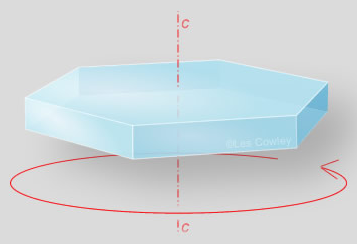Plate Orientation & Plate Halos
Plate Orientation & Plate Halos: Exploring the Phenomenon in Detail
Plate orientation and plate halos are fascinating atmospheric optics phenomena that occur when plate crystals, which are hexagonal ice crystals, become oriented in a specific way as they drift downwards through the atmosphere. In this article, we will delve deeper into the intricacies of plate orientation and the resulting plate halos.
The Dynamics of Plate Orientation
When plate crystals descend, they naturally orient themselves in a maximum drag condition. This means that their large hexagonal end faces become nearly horizontal, while the crystal's "c" axis (parallel to the side face edges) aligns almost vertically. This configuration is dynamically stable, as even small deviations from the optimal orientation result in correcting forces that restore the crystals' alignment.
The prevalence of plate halos is a testament to the remarkable orientations of cloud crystals. Despite their slight wobbling, good halos occur when the "c" axis remains within a degree of vertical. It is awe-inspiring to think about the millions of cloud crystals in an ensemble, each capable of assuming all possible rotational positions around the "c" axis.
Unraveling Plate Halos
Plate halos, also known as plate arcs or halos, manifest in various forms depending on the paths of rays passing through the plate crystals. Let's explore some of these captivating phenomena:
-
Sundogs: Rays passing between vertical side faces inclined at a wedge angle of 60° create sundogs. Sundogs are vibrant patches of light that appear on either side of the Sun and often accompany plate halos.
-
Circumzenithal and Circumhorizon Arcs: Rays passing between one of the large horizontal faces and a side face (wedge angle of 90°) form circumzenithal and circumhorizon arcs. These arcs are beautiful displays of colors that encircle the zenith and horizon, respectively.
-
Subsun and Sun Pillars: Reflections off the horizontal faces of plate crystals give rise to subsuns and sun pillars. Subsun refers to a bright spot of light appearing below the horizon, while sun pillars are vertical columns of light extending above or below the Sun.
-
Parhelic Circle: Reflections from the vertical faces of plate crystals contribute to the parhelic circle. The parhelic circle is a complete circle of light that intersects the horizon at the same height as the Sun.
Embracing the Wonders of Plate Orientation & Plate Halos
The intricate interplay between plate crystals, their orientations, and the paths of light rays passing through them creates a mesmerizing array of atmospheric optical phenomena. Plate orientation and the resulting plate halos offer us a glimpse into the awe-inspiring beauty and complexity of our atmosphere.
Next time you find yourself gazing at the sky, take a moment to appreciate the delicate dance of plate crystals and the captivating plate halos they produce. These natural wonders serve as a reminder of the intricacies and boundless wonders that exist within our world, waiting to be explored and admired.

As plate crystals drift downwards, they become oriented in a maximum drag condition. Their large hexagonal end faces are nearly horizontal and the dotted axis (the crystal ‘c’ axis parallel to the side face edges) is almost vertical.
The configuration is dynamically stable in that small deviations produce correcting forces that restore the orientation.
All crystals wobble slightly but good halos result when the c axis stays within a degree of vertical. That halos are so frequent testify to the remarkably good orientations of cloud crystals.
The plates are free to take all rotational orientations about the c-axis. This does not mean that individual crystals 'spin' but rather that an ensemble of millions of crystals in a cloud has all possible rotational positions.
The resulting halos are called plate arcs or halos.
Rays passing between vertical side faces inclined with a wedge angle of 60° form sundogs. Rays passing between one of the large horizontal faces and a side face (wedge angle of 90°) form the circumzenithal and circumhorizon arcs.
Reflections off horizontal faces give us a subsun and sun pillars. Reflections from vertical faces contribute to the parhelic circle.

Images: parhelia, Stan Richard cza, Jane Wertenberger
cha, Mark Sorenson subhorizon arcs, Don Davis
pillar,Dave Liquorice Thumbnails lacking a
larger version will be updated soon.
Note: this article has been automatically converted from the old site and may not appear as intended. You can find the original article here.
Reference Atmospheric Optics
If you use any of the definitions, information, or data presented on Atmospheric Optics, please copy the link or reference below to properly credit us as the reference source. Thank you!
-
<a href="https://atoptics.co.uk/blog/plate-orientation-plate-halos/">Plate Orientation & Plate Halos</a>
-
"Plate Orientation & Plate Halos". Atmospheric Optics. Accessed on April 28, 2024. https://atoptics.co.uk/blog/plate-orientation-plate-halos/.
-
"Plate Orientation & Plate Halos". Atmospheric Optics, https://atoptics.co.uk/blog/plate-orientation-plate-halos/. Accessed 28 April, 2024
-
Plate Orientation & Plate Halos. Atmospheric Optics. Retrieved from https://atoptics.co.uk/blog/plate-orientation-plate-halos/.